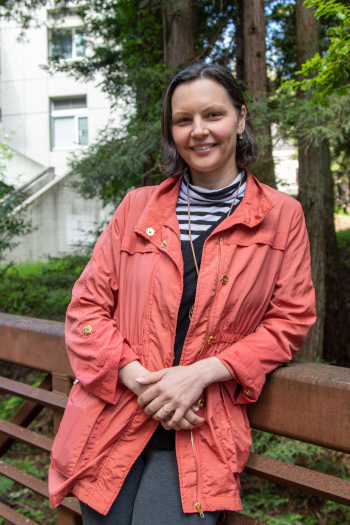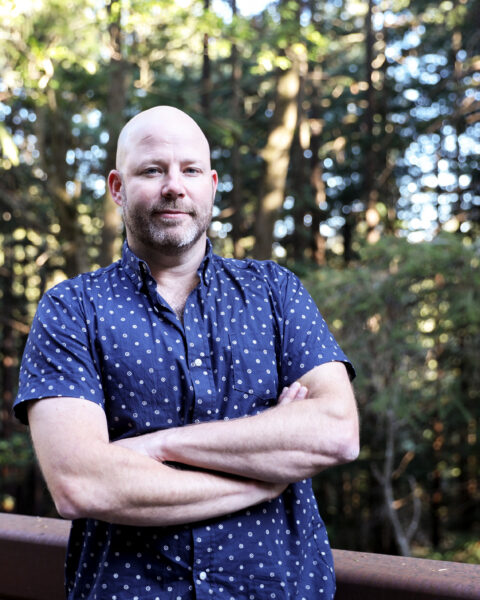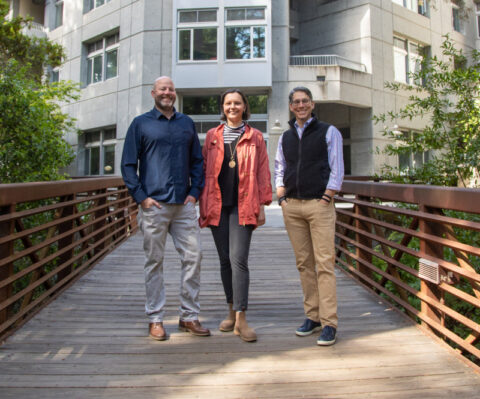Above: Ribosome as part of a biological-cell-constructing mRNA molecule (3D illustration courtesy Christoph Burgstedt/iStock/Getty Images Plus)
One day in 2018, UCSC Associate Professor of Molecular, Cell and Developmental Biology Olena Vaske received a large electronic file from doctors at Stanford Medicine. The file contained data on a toddler with a rare cancer in his liver and lungs. Other researchers had already sequenced the boy’s DNA—the genetic material he inherited from his parents—and found nothing that explained his disease. Standard chemotherapy had not stopped his tumors from growing, and his doctors were stumped about what to do next.
They had turned to Vaske because her lab specializes in the analysis of RNA—ribonucleic acid.
For many years, RNA was considered the humdrum cousin of DNA—just a passive messenger. Cells copy the master instructions contained in DNA to strands of RNA to move throughout a cell and translate into proteins—the primary physical workhorses of cells.
In recent years, however, scientists have begun to better appreciate the complexity of these RNA messages. In their journey between DNA and protein, RNA molecules can be cut and spliced, activated or silenced, folded into myriad origami-like shapes, stabilized or degraded away into nothing. These steps control not only how much of a given protein is eventually produced by a cell, and for how long, but even the structure and function of that final protein.

Olena Vaske, associate professor of molecular, cell and developmental biology (photo by Carolyn Lagattuta)
When Vaske and her colleagues analyzed RNA from the Stanford patient’s liver, they discovered high levels of two particular RNA molecules. This meant extra proteins were being produced; in both cases, scientists had already linked the proteins to other cancers, and there were drugs to block them.
In the coming months, the boy’s doctors tried first one, and then the other, of the drugs suggested by Vaske’s RNA analysis—neither of which had been previously tested in his cancer type. His tumors shrank enough for surgeons to remove the remaining cancer. Eventually, he showed no signs of disease, and today he’s a healthy second-grader.
“This is one of our resounding success stories. Being able to look at a patient’s RNA is an amazing and powerful tool,” says Vaske.
For more than 30 years, researchers at the UCSC Center for Molecular Biology of RNA have studied every angle of RNA; the center is considered one of the top RNA research facilities in the world.
Now many of these lines of research, including Vaske’s, are converging on human disease. Together, they’re revealing a new understanding of the role of RNA in health and suggesting ways that RNA-based treatments could cure everything from cancer to rare genetic diseases.
Cut-and-paste maps
When he launched his lab at UC Santa Cruz in 2008, Jeremy Sanford, professor of molecular, cell and developmental biology, set out to understand proteins that bind directly to RNA, helping control their movement and processing. Some of these proteins help transport messenger RNA to where it’s needed in a cell, and others act like tethers, attaching RNA to the cellular machinery that produces proteins from its code. But many of the proteins are also responsible for the process known as splicing—a cut-and-paste system that removes unnecessary parts of RNA and stitches together the essential parts.

Jeremy Sanford, professor of molecular, cell and developmental biology
“There are all these different steps that have to occur for an RNA molecule to be translated into protein,” Sanford says. “We wanted to know: How are all those steps regulated, and how are they interrelated?”
Researchers already knew that splicing was important; if this process doesn’t happen correctly, cells have developmental defects or die.
In 2009, Sanford mapped out more than 26,000 spots on the human genome where one splicing protein, SFRS1, can latch onto RNA. Then Sanford noted something else: His map of SFRS1 binding sites closely overlapped with a map of the spots in the human genome that were frequently mutated in genetic diseases.
“We began to think that maybe this was a widespread mechanism underlying human disease; maybe lots of disease mutations are altering RNA splicing,” says Sanford.
Imagine taking a choose-your-own-adventure book and changing the instructions on the bottom of each page—“turn to page 14” might become “turn to page 43.” These kinds of changes could befuddle a reader just as much as alterations to the story itself, leading to out-of-order plot lines, missed sections, or the same page read multiple times. Sanford began to suspect that in the same way, some disease-causing genetic mutations altered RNA’s splicing instructions rather than the parts of RNA that directly encode proteins.
Sanford, after his mapping project and follow-up work, had an overwhelming list of more than 7,000 disease-related genetic mutations that might influence RNA splicing. So when an undergraduate approached him looking for a research project, Sanford got an idea—why not have students help comb through the massive list? The UC Santa Cruz courses Toxic RNA Lab I, II, and III were born.
As they learn how to carry out genetic and molecular biology experiments, undergraduates in the Toxic RNA Lab each study a genetic mutation from Sanford’s list, probing whether it alters RNA splicing.
In recent years, Toxic RNA Lab students have studied nearly 100 genetic mutations associated with the rare blood-clotting disease hemophilia A. Each mutation was near a potential protein-RNA interaction site, and the students pinpointed a handful of mutations that altered the way RNA is spliced. They discovered that because of these splicing changes, a blood-clotting protein called factor 8 (F8) was not being produced correctly.
When structures inspire treatments

Michael Stone, professor of chemistry and biochemistry (photo by Carolyn Lagattuta)
Over the last few decades, UC Santa Cruz Professor of Chemistry and Biochemistry Michael Stone has developed technologies to determine RNA’s precise structure and the way RNA structure must dynamically change to function in cells. With these methods, Stone can work out how a long strand of RNA is folded, origami-like, into a framework.
“This kind of structural study is actually based on very old techniques, but we’ve put a modern spin on it,” explains Stone. “Traditionally, you could only do this on purified RNA molecules in a test tube. Now it’s possible to do this work inside living cells.”
That advance, Stone says, lets his team find correlations between RNA structures and how a cell is functioning at any given time.
When the students in Toxic RNA Lab pinpointed one region of the F8 RNA as critical for mediating splicing, Sanford wondered whether the structure of the F8 RNA could reveal why this area was so fragile. He turned to Stone for help. Together, they showed that the disease-linked F8 mutations made the RNA fold up in a different way than usual. This change interferes with RNA splicing, and, as a result, disrupts the function of the F8 protein.
The researchers reasoned that if they could design a drug—called an antisense oligonucleotide, or ASO—to bind to the F8 RNA, it might be able to coax the RNA to splice correctly. Together, Stone and Sanford are now taking this approach, developing and testing ASOs and recruiting citizen scientists to brainstorm new ASO designs.
Converging to treat disease
In early 2020, Vaske, Sanford, and Stone co-founded the COVID-19 diagnostic testing laboratory at UC Santa Cruz. With their expertise in RNA biology, each felt a drive to contribute to the fight against SARS-CoV-2, an RNA virus. The incredible success of their collaboration (the testing center processed more than 200,000 tests in 2020 and 2021) inspired the three researchers to look for ways to keep teaming up.
“The three of us come together in this kind of Venn diagram, where Olena [Vaske] has the clinical genetics expertise, Jeremy [Sanford] is an RNA splicing expert, and I think of everything in terms of RNA structure,” says Stone. “Where these things converge is targeted RNA therapeutics.”

“The three of us come together in this kind of Venn diagram, where Olena [Vaske] has the clinical genetics expertise, Jeremy [Sanford] is an RNA splicing expert, and I think of everything in terms of RNA structure,” says Stone. “Where these things converge is targeted RNA therapeutics.” (Photo by Carolyn Lagattuta)
“My dream is to have a one-stop diagnostic test that looks only at RNA to diagnose disease,” says Vaske.
At the same time, Sanford and Stone want to apply the approach they’ve taken for hemophilia A to other diseases. They think ASO drugs, some of which are already on the market for rare genetic diseases, offer a promising treatment for numerous conditions in which RNA structure and RNA splicing have gone awry—whether those diseases come from Sanford’s list of overlapping mutations or Vaske’s clinical partners.
Here’s how their collaboration might work: A physician sends Vaske the RNA sequence of a patient with a mysterious or rare ailment. Vaske compares the patient’s RNA to thousands of RNA sequences in her database and discovers an unusual change to the RNA near where a splicing protein binds. Sanford re-creates the altered RNA in the lab and shows that, indeed, the RNA is not getting spliced correctly, leading to changes in the resulting protein. Stone carries out his structural studies and identifies how the RNA is folding incorrectly to prevent or change splicing. The results let him quickly design and produce an ASO to stabilize the RNA and treat the patient.
“The dream would be that we accelerate the discovery process and have this pipeline where we can actually fix these RNA splicing defects in patients, in a very personalized way,” says Stone. “In principle, if we had all the money and resources in the world, we could actually be doing this now, since we already have the tools we need.”
For now, though, the team is improving its prediction of which ASOs could be most effective to repair which RNA structures. Already, their work with F8 RNA is helping Stone and Sanford get better at up-front ASO design. And the students in Toxic RNA Lab are tackling a new set of mutations: those linked to cancers.
“We’re all really excited to have an impact and create new knowledge,” says Sanford. “I think this convergence of rare disease research and ASO drugs is starting to really gain momentum.”
To support the UCSC Center for Molecular Biology of RNA, make a gift to the RNA Center General Fund.

